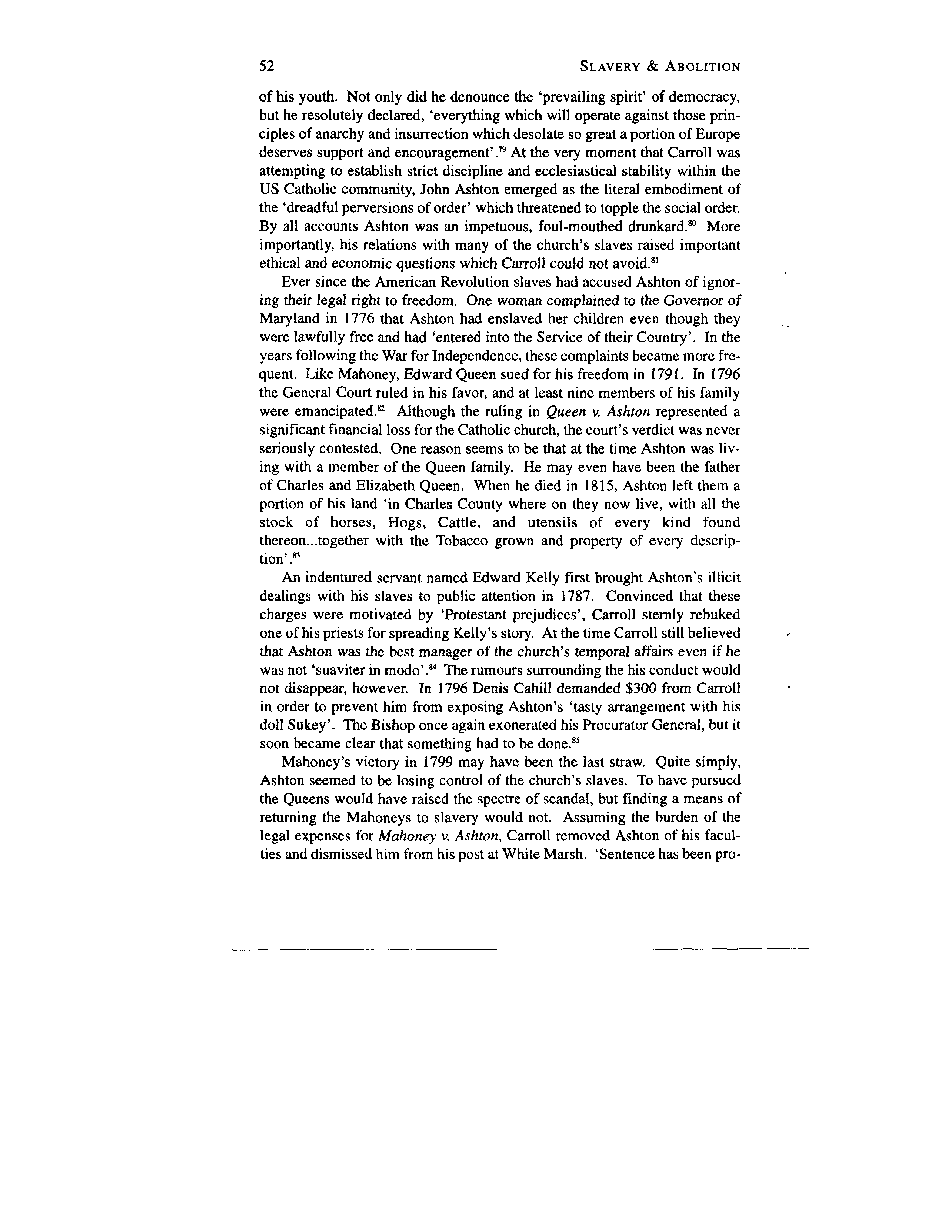|
52 SLAVERY & ABOLITION
of his youth. Not only did he denounce the 'prevailing spirit' of democracy,
but he resolutely declared, 'everything which will operate against those prin-
ciples of anarchy and insurrection which desolate so great a portion of Europe
deserves support and encouragement'." At the very moment that Carroll was
attempting to establish strict discipline and ecclesiastical stability within the
US Catholic community, John Ashton emerged as the literal embodiment of
the 'dreadful perversions of order' which threatened to topple the social order.
By all accounts Ashton was an impetuous, foul-mouthed drunkard.80 More
importantly, his relations with many of the church's slaves raised important
ethical and economic questions which Carroll could not avoid.81
Ever since the American Revolution slaves had accused Ashton of ignor-
ing their legal right to freedom. One woman complained to the Governor of
Maryland in 1776 that Ashton had enslaved her children even though they
were lawfully free and had 'entered into the Service of their Country'. In the
years following the War for Independence, these complaints became more fre-
quent. Like Mahoney, Edward Queen sued for his freedom in 1791. In 1796
the General Court ruled in his favor, and at least nine members of his family
were emancipated.82 Although the ruling in Queen v. Ashton represented a
significant financial loss for the Catholic church, the court's verdict was never
seriously contested. One reason seems to be that at the time Ashton was liv-
ing with a member of the Queen family. He may even have been the father
of Charles and Elizabeth Queen. When he died in 1815, Ashton left them a
portion of his land 'in Charles County where on they now live, with all the
stock of horses, Hogs, Cattle, and utensils of every kind found
thereon...together with the Tobacco grown and property of every descrip-
tion'.83
An indentured servant named Edward Kelly first brought Ashton's illicit
dealings with his slaves to public attention in 1787. Convinced that these
charges were motivated by 'Protestant prejudices', Carroll sternly rebuked
one of his priests for spreading Kelly's story. At the time Carroll still believed
that Ashton was the best manager of the church's temporal affairs even if he
was not 'suaviter in modo' .M The rumours surrounding the his conduct would
not disappear, however. In 1796 Denis Cahill demanded $300 from Carroll
in order to prevent him from exposing Ashton's 'tasty arrangement with his
doll Sukey'. The Bishop once again exonerated his Procurator General, but it
soon became clear that something had to be done.85
Mahoney's victory in 1799 may have been the last straw. Quite simply,
Ashton seemed to be losing control of the church's slaves. To have pursued
the Queens would have raised the spectre of scandal, but finding a means of
returning the Mahoneys to slavery would not. Assuming the burden of the
legal expenses for Mahoney v. Ashton, Carroll removed Ashton of his facul-
ties and dismissed him from his post at White Marsh. 'Sentence has been pro-
�
|

